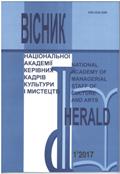THE PHENOMENON OF CHAMBER ENSEMBLE PERFORMANCE: TO THE ISSUES OF PROFESSIONAL TERMINOLOGY
THE PHENOMENON OF CHAMBER ENSEMBLE PERFORMANCE: TO THE ISSUES OF PROFESSIONAL TERMINOLOGY
Author(s): Liudmіla PovzunSubject(s): Anthropology, Music
Published by: Національна академія керівних кадрів культури і мистецтв
Keywords: chamber ensemble performance; ensemble playing; ensemble dynamics; ensemble articulation;
Summary/Abstract: The purpose of the study. Within the theory of performance, methodologically studied in scientific works of E. Nazaikinskyi, V. Medushevskyi, the theory of chamber ensemble performing claims independent quality and appropriate conceptual and terminological framework. At present, there is a need for a common scientific and methodological foundation of theory and history of instrumental chamber ensemble performance, which should be based on understanding the processes of generic and species of chamber-ensemble genres and instrumental ensemble performance. The study of the problems of chamber-ensemble performance is inextricably related to questions of art-space in the ensem-ble subspecies, which requires expanding of conceptual and terminology according to a systematic approach to the study of the historical foundations and theoretical bases of chamber ensemble performance that transforms into a sepa-rate kind of music. Methodology of study consists in applying a systematic method that combines historical and theo-retical approaches to the study of musicology processes of instrumental chamber ensemble genres and the art of cham-ber ensemble performance; hermeneutic method is used for the interpretation of concepts relating to chamber instrumental ensemble work. Scientific novelty. Expanding artistic interpretation of time-space, we propose an isolation of concept of instrumental ensemble performing time-space that provides different quantitative/qualitative indicators of ensemble structure, various types of communicating interactions, various acoustic and spatial conditions and the introduction of the concept of dynamotop as the process of harmonizing-balancing of simultaneous sound in different aesthetic, social-cultural and acoustic-spatial performance conditions. The proposed terminology of micro-structural, dynamic and articulation instrumental ensemble indicators extends the methodological basis of teaching and performing instrumental ensemble practice. Conclusions. Instrumental and ensemble performance is a system of combining per-sonal artistic and performing intentions of each of the instrumentalists in an integrated common interpretation with the coordination of all the components of ensemble complex, which includes both direct psychological and communicative interaction of the participants – performers, as well as timbre, acoustic, dynamic properties of all instruments involved in the ensemble composition. This system includes mental sets at various levels of action: for practical playing activities, using professional skills and technology of instrumental performance, which involves long-term mental sets for living of artistic-sound image in real playing time, which involves short-term and simultaneous setting.
Journal: Вісник Національної академії керівних кадрів культури і мистецтв
- Issue Year: 2017
- Issue No: 1
- Page Range: 137-142
- Page Count: 6
- Language: English

